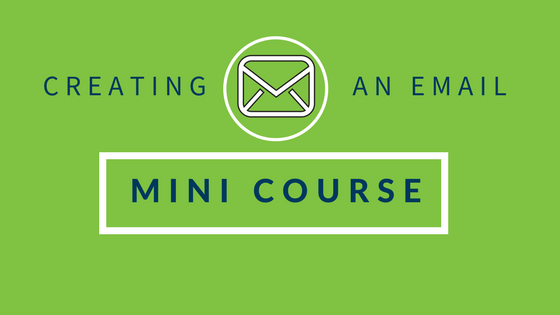In the last post, we looked at the best strategies for getting started with an automated e-mail campaign and the most important e-mails two common formats for automated e-mail marketing campaigns: the mini e-course and the weekly tips ezine. If you missed the last post, you can review the automated e-mail marketing models here.
Once you’re familiar with two of the basic types your automated e-mail marketing campaign can take, select a campaign type and read on to learn about the best strategies for getting started with an automated e-mail campaign.
Creating an eCourse
An eCourse, or e-mail mini-course, is one of the most common opt-in rewards offered to subscribers so let’s talk about how to create an email mini-course that promotes a specific product and builds a stronger relationship with your followers.
Let’s start with the basics: an eCourse is simply a series of e-mails or “lessons” that are automatically sent to your subscribers in a pre-determined sequence. By using an autoresponder service such as aWeber or 1ShoppingCart you can easily create your eCourse series to broadcast each lesson on a timed basis automatically.
The best mini-courses I’ve created consist of 5 to 7 lessons. Each lesson is essentially a 500 to 800 word article, and includes a promotion for the product you’re selling at the end of the day’s lesson.
Structuring Your eCourse
The first step in creating your eCourse is to define the structure. A mini-course is easy to put together once you’ve started writing some content. In fact, if you’ve been in business for a while and write articles frequently or publish a regular newsletter or blog, chances are you could already have the content you need to create an e-course. To create your eCourse content, you could take 5 of your best articles and organize them into a mini-course.
But just taking five unrelated articles and slapping them together into an eCourse won’t be very effective. Your eCourse should have a specific topic. For example, one of my first projects as a Virtual Assistant was to turn a keynote speech that one of my clients would regularly give into an eCourse. The topic of the mini-course was “6 Steps to Creating Info Products for Money, Image and Success” and the mini-course promoted a 90 day group coaching program that was designed to help online entrepreneurs create information products (ebooks, DVDs, CDs, etc.).
So you need a specific topic for your eCourse and then 5 to 7 500 to 800-word articles that are related to that topic and, more importantly, related to the product you’re trying to sell. For example, “10 Steps to Start Your Internet Business Right and Save Money, Time, and Energy” which could be used to promote a DVD tutorial set on how to start an online business or even a website building service.
Once you have a topic selected, you’ll need to create content. And not just any old content, you want to give away some of your best tips and materials in your eCourse. The goal here is to share valuable information and create a relationship with your follower. You want your content to shine so that your reader thinks “If this is what I’m getting for free, I know the product will be fantastic!”
This type of strategy works really well for an author. If you’re a published author, you could create your mini-course based on the information in five chapters of your book. Or you could hire a ghostwriter to write five 500-word articles based on five chapters in your book. I know what you’re thinking: But if I give away the best information in my book, why would they buy my book? Even though the mini-course gives away a lot of the information that’s in your book, your book is still more complete. After all, your eCourse lessons are probably a synopsis of your book’s chapter. The book would be more complete and would contain additional valuable information people would want to find out anyway!
The actual structure of each lesson is fairly simple. Just follow the steps outlined below:
- Start each lesson with a short sentence that outlines the topic of this lesson and gets the reader excited about what they’re going to learn.
- Post the content of your lesson
- Finish each lesson with a short sentence giving them a preview of what’s coming in the next lesson.
- End each lesson with a P.S. that includes a promotion for the product or service you’re hoping to sell
- Start the next lesson by quickly reviewing what they learned in the previous lesson and outlining the content of the current lesson.
- Rinse and repeat all the steps until the mini-course is complete.
Using the outline above as a guideline, your first task is to select a topic and write five 800-word articles that support that topic. Once that’s done, you’ll have the basic structure of your mini-course and you’ll be ready for the next step.
Delivering Your eCourse
When it comes to delivering your eCourse, that is, emailing it to your new subscriber, you have two options:
- Deliver the entire eCourse by e-mail, either as text or an HTML formatted e-mail
- Post the eCourse online and send your subscribers a teaser-e-mail with the link where they can access the new lesson.
Both options work well. I outlined both in a previous article on How To Create an eCourse so won’t go into too much detail here. If you’re short on time, your best option would be option 1 as a text-only e-mail. That way, you won’t have to spend more time putting together web pages for each lesson or formatting an HTML e-mail.
If you do have time, consider creating a web page for each lesson and posting it to your website. Then you can opt to deliver the entire course by e-mail using option 1 or simply direct readers to your web page as in option 2. Be sure to check the How To Create an eCourse article for full details.
Scheduling Your eCourse
Now that you have the lessons written and you’ve selected your delivery method, you’re ready to put the course into your autoresponder service. If you don’t have an account already, you’ll need to sign up with aWeber or 1ShoppingCart or some other ezine service. Once you have an account, you’ll need to establish a schedule for your mini-course (i.e. how many days you want to pass between mini-course lessons).
The most common delivery method is to schedule a new lesson every two days. When you’re first getting started with scheduling eCourses, it may be helpful to write out the schedule on paper first before you set it up online. Using the two day delay method, you’ll be scheduling your lessons as follows:
Day 0 Introduction e-mail
Day 1 Lesson #1
Day 3 Lesson #2
Day 5 Lesson #3
Day 7 Lesson #4
Day 9 Lesson #5
Using this basic structure, you’ll be able to create an effective eCourse. There are a few other teasers that you can throw in. I’ve had clients who throw in a special one-time offer after Lesson #3 or even a survey in the mix. I’ve even had clients post a special e-mail on Day 14 (so about a week after the course ends) with another special offer or even a final e-mail that summarizes your other resources, products, websites or blogs. There are quite a few things that can be done but it’s important that the special offers not detract from the goal of sharing valuable information with your subscribers. If you start with the basic e-course, you can always add in the extras later. Just be sure you’ve designed an eCourse that gives value to your prospects. Otherwise, all the special offers in the world will fall on deaf ears.
Upping the Ante
As I mentioned earlier, the automated mini-course, or eCourse, is one of the most popular opt-in enticements. But there are many other strategies that you can use to automate your marketing. I reviewed a few strategies at the start of this series. If you missed part 1, you can view the different e-mail marketing models here.
What we haven’t covered yet is how to automate your new media marketing efforts. Smart and savvy business owners like yourself know that the hottest trend in online marketing right now is online video. Why not harness the power of online video and tap into the new media marketing revolution by creating a Video of the Week e-mail campaign. They video need not be long, five minutes is more than enough air time. The model is similar to the recipe of the week or tip of the week but instead of being a text only delivery, you’re creating a video tip and broadcasting the link to the video replay.
Not a fan of video, the same thing can be done as an audio tip of the week. Be sure to harness the power of new media, especially if you’re in an industry or niche that hasn’t caught the new media wave. Think outside the digital box and you’re sure to start standing out from your competitors.
Whatever strategy you decide to follow, make sure you take advantage of the possibilities of automation in your e-mail marketing.
Share and Grow
- Do you use mini e-courses in your marketing efforts?
- Have you tried combining special one-time offers in your mini-course?
- Are you part of the new media revolution?
Share your thoughts and experiences below. Would love to hear your thoughts.







Thank you, thank you, thank you! Exactly what I have been looking for.